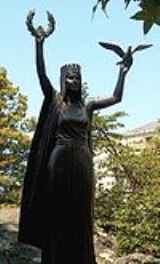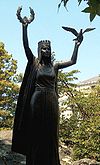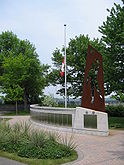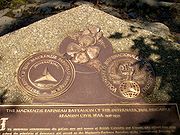
Mackenzie-Papineau Battalion
Encyclopedia
The Mackenzie–Papineau Battalion or Mac-Paps were a battalion
of Canadians
who fought as part of the XV International Brigade
on the Republican side
in the Spanish Civil War
. Except for France, no other country gave a greater proportion of its population as volunteers in Spain than Canada. The first Canadians in the conflict were dispatched mainly with the U.S. Abraham Lincoln Battalion and later the North American George Washington Battalion, with about forty Canadians serving in each group. The Lincoln Brigade was involved in the Battle of Jarama
in which nine Canadians are known to have been killed.
 By summer 1937 some 1,200 Canadians were involved in the conflict and a separate battalion was formed for them in early May. Two months later it was named for William Lyon Mackenzie
By summer 1937 some 1,200 Canadians were involved in the conflict and a separate battalion was formed for them in early May. Two months later it was named for William Lyon Mackenzie
and Louis-Joseph Papineau
, who led the 1837 Rebellions. The battalion was formed at Albacete
, Spain
under the command of Edward Cecil-Smith, a Montreal-based journalist and trade union organizer.
The soldiers who would make up the Mackenzie–Papineau Battalion came from all parts of Canada. The majority of soldiers in the battalion were American. Unlike Britain and the United States, where a significant number of students and intellectuals enlisted, the Canadian contingent was almost wholly working class
. Labourers had been driven to the left by their experiences during the Great Depression
.
Canadian volunteers included members of the Communist Party
. In general, the respondents were self-educated about the conflict in Spain, and about the possible repercussions for democracy in Europe and the world. Many other moderate groups also supported the Spanish Republicans and organized the Committee to Support Spanish Democracy. A good percentage of those who enlisted had been born in Europe, the two largest groups being Finns and Ukrainians
. Many of these Finns were from US Finnish speaking communities. As casualties mounted many Spanish volunteers and later conscripts were incorporated into the unit.
 In April 1937 the Canadian government passed the Foreign Enlistment Act, outlawing participation by Canadians in foreign wars, and the Customs Act, which provided for government control over arms exports. Thus it became illegal for Canadian citizens to serve in the Spanish Civil War. The Committee to Support Spanish Democracy halted sending troops over, but continued to recruit medics. The recruiting of fighters was left to the Communist Party. The government refused to issue passport
In April 1937 the Canadian government passed the Foreign Enlistment Act, outlawing participation by Canadians in foreign wars, and the Customs Act, which provided for government control over arms exports. Thus it became illegal for Canadian citizens to serve in the Spanish Civil War. The Committee to Support Spanish Democracy halted sending troops over, but continued to recruit medics. The recruiting of fighters was left to the Communist Party. The government refused to issue passport
s to those they felt might be going to fight in Spain and sent Royal Canadian Mounted Police
(RCMP) officers to spy on leftist activities.
Therefore, any Canadians who meant to serve in Spain had to travel under false pretenses. For the most part they went first to Toronto
, where they met at the headquarters for the operation at the corner of Queen and Spadina. Applicants were screened. For the most part anyone intending to enlist had to have had a history of working for the left. The more drunken and adventurous types who made up part of the European volunteers were also weeded out, leaving those who were well and truly committed to the politics of the fight against fascism
. All these factors, along with the comparatively mature age of the soldiers – 61.5% were over thirty – resulted in a powerful and committed force. From Toronto they would go to Montreal
, or more frequently New York
, across the Atlantic Ocean
to France
, then by ship or on foot across the Pyrenees
to Spain.
After their initial training in Albacete
the Canadians, who had been added to the XV International Brigade
entered the war. Many saw their first action suppressing the Barcelona General Strike organized by the anarchists and POUM
directed against the Spanish Republic. This was an engagement immortalized by George Orwell's "Homage to Catalonia". Their first battle against the fascists was at Jarama
near Madrid
, between February and June 1937, followed by a battle at Brunete
in July of that year. Although the casualties were horrendous, the Nationals were halted. Shortly afterwards, the Mackenzie–Papineau Battalion became the third battalion of the XV International Brigade.
(December 1937-March 1938), the Aragon Offensive
(March-April, more commonly known to the Republican forces as the Retreats, and finally, the Battle of the Ebro
(July–September). They were ferocious warriors but were unable to overcome a powerful fascist opposition backed by Nazi Germany
and Fascist Italy
, and despite a complete lack of support from any of the Western democracies.
In the end, Spanish Prime Minister
Negrín’s conscience caused him to order the International Brigades withdrawn on September 21, 1938. Madrid fell six months later on March 28, 1939. In the battles in which they fought, as well as due to atrocities committed upon them when taken prisoner, 721 of the 1,546 Canadians known to have fought in Spain lost their lives.
 The way home was arduous. The Canadian government continued its policy of ignoring or even persecuting the veterans of Spain. Money had to be scratched together to get them home; some were arrested in France. It was not until January 1939 that the government agreed the fighters could return to Canada. Upon their return to Canada, many were investigated by the RCMP and denied employment. Even though Canada went on to contribute vastly to the Allied
The way home was arduous. The Canadian government continued its policy of ignoring or even persecuting the veterans of Spain. Money had to be scratched together to get them home; some were arrested in France. It was not until January 1939 that the government agreed the fighters could return to Canada. Upon their return to Canada, many were investigated by the RCMP and denied employment. Even though Canada went on to contribute vastly to the Allied
side against fascism in World War II
, the battalion’s contribution has never been formally recognized. Standard histories of Canada rarely mention the Spanish Civil War. A good number of the Mac-Pap veterans fought in the Second World War, but a number were prohibited due to "political unreliability".
The Canadians who died in the Spanish Civil War are not included in the Books of Remembrance in the Peace Tower
and their sacrifice is not commemorated on federal war memorials or in Remembrance Day
services. Those who survived the war are not entitled to veterans' benefits. Although the soldiers and the war is largely forgotten, a monument to the Mackenzie–Papineau Battalion can be found in Victoria, British Columbia
. A national monument to the Mac-Pap veterans was erected in Ottawa
in 2001. It includes the names of the 1,546 Canadian volunteers who served in Spain. This number includes all those who served in the Mac-Pap battalion, the medical, communications, transportation and translation corps, or in other brigades.
One of the few Canadians to attain recognition for their service in Spain is Dr. Norman Bethune
, who greatly developed the use of mobile army medical units
for the Republican side.
Battalion
A battalion is a military unit of around 300–1,200 soldiers usually consisting of between two and seven companies and typically commanded by either a Lieutenant Colonel or a Colonel...
of Canadians
Canada
Canada is a North American country consisting of ten provinces and three territories. Located in the northern part of the continent, it extends from the Atlantic Ocean in the east to the Pacific Ocean in the west, and northward into the Arctic Ocean...
who fought as part of the XV International Brigade
XV International Brigade
The XV International Brigade fought for the Spanish Second Republic in the Spanish Civil War as a part of the International Brigades. It was mustered at Albacete in Spain, in January 1937, comprising many English-speaking volunteers - arranged into a mostly British British Battalion and a mostly...
on the Republican side
Second Spanish Republic
The Second Spanish Republic was the government of Spain between April 14 1931, and its destruction by a military rebellion, led by General Francisco Franco....
in the Spanish Civil War
Spanish Civil War
The Spanish Civil WarAlso known as The Crusade among Nationalists, the Fourth Carlist War among Carlists, and The Rebellion or Uprising among Republicans. was a major conflict fought in Spain from 17 July 1936 to 1 April 1939...
. Except for France, no other country gave a greater proportion of its population as volunteers in Spain than Canada. The first Canadians in the conflict were dispatched mainly with the U.S. Abraham Lincoln Battalion and later the North American George Washington Battalion, with about forty Canadians serving in each group. The Lincoln Brigade was involved in the Battle of Jarama
Battle of Jarama
The Battle of Jarama was an attempt by General Franco's Nationalists to dislodge the Republican lines along the river Jarama, just east of Madrid, during the Spanish Civil War...
in which nine Canadians are known to have been killed.
History

William Lyon Mackenzie
William Lyon Mackenzie was a Scottish born American and Canadian journalist, politician, and rebellion leader. He served as the first mayor of Toronto, Upper Canada and was an important leader during the 1837 Upper Canada Rebellion.-Background and early years in Scotland, 1795–1820:Mackenzie was...
and Louis-Joseph Papineau
Louis-Joseph Papineau
Louis-Joseph Papineau , born in Montreal, Quebec, was a politician, lawyer, and the landlord of the seigneurie de la Petite-Nation. He was the leader of the reformist Patriote movement before the Lower Canada Rebellion of 1837–1838. His father was Joseph Papineau, also a famous politician in Quebec...
, who led the 1837 Rebellions. The battalion was formed at Albacete
Albacete
Albacete is a city and municipality in southeastern Spain, 258 km southeast of Madrid, the capital of the province of Albacete in the autonomous community of Castile-La Mancha. The municipality had a population of c. 169,700 in 2009....
, Spain
Spain
Spain , officially the Kingdom of Spain languages]] under the European Charter for Regional or Minority Languages. In each of these, Spain's official name is as follows:;;;;;;), is a country and member state of the European Union located in southwestern Europe on the Iberian Peninsula...
under the command of Edward Cecil-Smith, a Montreal-based journalist and trade union organizer.
The soldiers who would make up the Mackenzie–Papineau Battalion came from all parts of Canada. The majority of soldiers in the battalion were American. Unlike Britain and the United States, where a significant number of students and intellectuals enlisted, the Canadian contingent was almost wholly working class
Working class
Working class is a term used in the social sciences and in ordinary conversation to describe those employed in lower tier jobs , often extending to those in unemployment or otherwise possessing below-average incomes...
. Labourers had been driven to the left by their experiences during the Great Depression
Great Depression
The Great Depression was a severe worldwide economic depression in the decade preceding World War II. The timing of the Great Depression varied across nations, but in most countries it started in about 1929 and lasted until the late 1930s or early 1940s...
.
Canadian volunteers included members of the Communist Party
Communist Party of Canada
The Communist Party of Canada is a communist political party in Canada. Although is it currently a minor or small political party without representation in the Federal Parliament or in provincial legislatures, historically the Party has elected representatives in Federal Parliament, Ontario...
. In general, the respondents were self-educated about the conflict in Spain, and about the possible repercussions for democracy in Europe and the world. Many other moderate groups also supported the Spanish Republicans and organized the Committee to Support Spanish Democracy. A good percentage of those who enlisted had been born in Europe, the two largest groups being Finns and Ukrainians
Ukrainians
Ukrainians are an East Slavic ethnic group native to Ukraine, which is the sixth-largest nation in Europe. The Constitution of Ukraine applies the term 'Ukrainians' to all its citizens...
. Many of these Finns were from US Finnish speaking communities. As casualties mounted many Spanish volunteers and later conscripts were incorporated into the unit.

Passport
A passport is a document, issued by a national government, which certifies, for the purpose of international travel, the identity and nationality of its holder. The elements of identity are name, date of birth, sex, and place of birth....
s to those they felt might be going to fight in Spain and sent Royal Canadian Mounted Police
Royal Canadian Mounted Police
The Royal Canadian Mounted Police , literally ‘Royal Gendarmerie of Canada’; colloquially known as The Mounties, and internally as ‘The Force’) is the national police force of Canada, and one of the most recognized of its kind in the world. It is unique in the world as a national, federal,...
(RCMP) officers to spy on leftist activities.
Therefore, any Canadians who meant to serve in Spain had to travel under false pretenses. For the most part they went first to Toronto
Toronto
Toronto is the provincial capital of Ontario and the largest city in Canada. It is located in Southern Ontario on the northwestern shore of Lake Ontario. A relatively modern city, Toronto's history dates back to the late-18th century, when its land was first purchased by the British monarchy from...
, where they met at the headquarters for the operation at the corner of Queen and Spadina. Applicants were screened. For the most part anyone intending to enlist had to have had a history of working for the left. The more drunken and adventurous types who made up part of the European volunteers were also weeded out, leaving those who were well and truly committed to the politics of the fight against fascism
Fascism
Fascism is a radical authoritarian nationalist political ideology. Fascists seek to rejuvenate their nation based on commitment to the national community as an organic entity, in which individuals are bound together in national identity by suprapersonal connections of ancestry, culture, and blood...
. All these factors, along with the comparatively mature age of the soldiers – 61.5% were over thirty – resulted in a powerful and committed force. From Toronto they would go to Montreal
Montreal
Montreal is a city in Canada. It is the largest city in the province of Quebec, the second-largest city in Canada and the seventh largest in North America...
, or more frequently New York
New York
New York is a state in the Northeastern region of the United States. It is the nation's third most populous state. New York is bordered by New Jersey and Pennsylvania to the south, and by Connecticut, Massachusetts and Vermont to the east...
, across the Atlantic Ocean
Atlantic Ocean
The Atlantic Ocean is the second-largest of the world's oceanic divisions. With a total area of about , it covers approximately 20% of the Earth's surface and about 26% of its water surface area...
to France
France
The French Republic , The French Republic , The French Republic , (commonly known as France , is a unitary semi-presidential republic in Western Europe with several overseas territories and islands located on other continents and in the Indian, Pacific, and Atlantic oceans. Metropolitan France...
, then by ship or on foot across the Pyrenees
Pyrenees
The Pyrenees is a range of mountains in southwest Europe that forms a natural border between France and Spain...
to Spain.
After their initial training in Albacete
Albacete
Albacete is a city and municipality in southeastern Spain, 258 km southeast of Madrid, the capital of the province of Albacete in the autonomous community of Castile-La Mancha. The municipality had a population of c. 169,700 in 2009....
the Canadians, who had been added to the XV International Brigade
XV International Brigade
The XV International Brigade fought for the Spanish Second Republic in the Spanish Civil War as a part of the International Brigades. It was mustered at Albacete in Spain, in January 1937, comprising many English-speaking volunteers - arranged into a mostly British British Battalion and a mostly...
entered the war. Many saw their first action suppressing the Barcelona General Strike organized by the anarchists and POUM
Poum
Poum is a commune in the North Province of New Caledonia, an overseas territory of France in the Pacific Ocean. The town of Poum is located in the far northwest, located on the southern part of Banare Bay, with Mouac Island just offshore....
directed against the Spanish Republic. This was an engagement immortalized by George Orwell's "Homage to Catalonia". Their first battle against the fascists was at Jarama
Battle of Jarama
The Battle of Jarama was an attempt by General Franco's Nationalists to dislodge the Republican lines along the river Jarama, just east of Madrid, during the Spanish Civil War...
near Madrid
Madrid
Madrid is the capital and largest city of Spain. The population of the city is roughly 3.3 million and the entire population of the Madrid metropolitan area is calculated to be 6.271 million. It is the third largest city in the European Union, after London and Berlin, and its metropolitan...
, between February and June 1937, followed by a battle at Brunete
Battle of Brunete
The Battle of Brunete , fought 15 miles west of Madrid, was a Republican attempt to alleviate the pressure exerted by the Nationalists on the capital and on the north during the Spanish Civil War...
in July of that year. Although the casualties were horrendous, the Nationals were halted. Shortly afterwards, the Mackenzie–Papineau Battalion became the third battalion of the XV International Brigade.
1938
Over the next year, the Mackenzie–Papineau Battalion fought in three major battles: the Battle of TeruelBattle of Teruel
The Battle of Teruel was fought in and around the city of Teruel during the Spanish Civil War in December 1937 – February 1938. The combatants fought the battle during the worst Spanish winter in twenty years. It was one of the bloodier actions of the war. The city changed hands several times,...
(December 1937-March 1938), the Aragon Offensive
Aragon Offensive
The Aragon Offensive was a Nationalist campaign during the Spanish Civil War, which began after the Battle of Teruel. The offensive began on March 7, 1938, and ended on April 19, 1938...
(March-April, more commonly known to the Republican forces as the Retreats, and finally, the Battle of the Ebro
Battle of the Ebro
The Battle of the Ebro was the longest and bloodiest battle of the Spanish Civil War...
(July–September). They were ferocious warriors but were unable to overcome a powerful fascist opposition backed by Nazi Germany
Nazi Germany
Nazi Germany , also known as the Third Reich , but officially called German Reich from 1933 to 1943 and Greater German Reich from 26 June 1943 onward, is the name commonly used to refer to the state of Germany from 1933 to 1945, when it was a totalitarian dictatorship ruled by...
and Fascist Italy
Kingdom of Italy (1861–1946)
The Kingdom of Italy was a state forged in 1861 by the unification of Italy under the influence of the Kingdom of Sardinia, which was its legal predecessor state...
, and despite a complete lack of support from any of the Western democracies.
In the end, Spanish Prime Minister
Prime Minister of Spain
The President of the Government of Spain , sometimes known in English as the Prime Minister of Spain, is the head of Government of Spain. The current office is established under the Constitution of 1978...
Negrín’s conscience caused him to order the International Brigades withdrawn on September 21, 1938. Madrid fell six months later on March 28, 1939. In the battles in which they fought, as well as due to atrocities committed upon them when taken prisoner, 721 of the 1,546 Canadians known to have fought in Spain lost their lives.

Allies of World War II
The Allies of World War II were the countries that opposed the Axis powers during the Second World War . Former Axis states contributing to the Allied victory are not considered Allied states...
side against fascism in World War II
World War II
World War II, or the Second World War , was a global conflict lasting from 1939 to 1945, involving most of the world's nations—including all of the great powers—eventually forming two opposing military alliances: the Allies and the Axis...
, the battalion’s contribution has never been formally recognized. Standard histories of Canada rarely mention the Spanish Civil War. A good number of the Mac-Pap veterans fought in the Second World War, but a number were prohibited due to "political unreliability".
The Canadians who died in the Spanish Civil War are not included in the Books of Remembrance in the Peace Tower
Peace Tower
The Peace Tower is a focal bell and clock tower, sitting on the central axis of the Centre Block of the Canadian parliament buildings in Ottawa, Ontario. The present incarnation replaced the Victoria Tower after the latter burned down in 1916, along with most of the Centre Block...
and their sacrifice is not commemorated on federal war memorials or in Remembrance Day
Remembrance Day
Remembrance Day is a memorial day observed in Commonwealth countries since the end of World War I to remember the members of their armed forces who have died in the line of duty. This day, or alternative dates, are also recognized as special days for war remembrances in many non-Commonwealth...
services. Those who survived the war are not entitled to veterans' benefits. Although the soldiers and the war is largely forgotten, a monument to the Mackenzie–Papineau Battalion can be found in Victoria, British Columbia
Victoria, British Columbia
Victoria is the capital city of British Columbia, Canada and is located on the southern tip of Vancouver Island off Canada's Pacific coast. The city has a population of about 78,000 within the metropolitan area of Greater Victoria, which has a population of 360,063, the 15th most populous Canadian...
. A national monument to the Mac-Pap veterans was erected in Ottawa
Ottawa
Ottawa is the capital of Canada, the second largest city in the Province of Ontario, and the fourth largest city in the country. The city is located on the south bank of the Ottawa River in the eastern portion of Southern Ontario...
in 2001. It includes the names of the 1,546 Canadian volunteers who served in Spain. This number includes all those who served in the Mac-Pap battalion, the medical, communications, transportation and translation corps, or in other brigades.
One of the few Canadians to attain recognition for their service in Spain is Dr. Norman Bethune
Norman Bethune
Henry Norman Bethune was a Canadian physician and medical innovator. Bethune is best known for his service in war time medical units during the Spanish Civil War and with the Communist Eighth Route Army during the Second Sino-Japanese War...
, who greatly developed the use of mobile army medical units
Mobile Army Surgical Hospital
The Mobile Army Surgical Hospital refers to a United States Army medical unit serving as a fully functional hospital in a combat area of operations. The units were first established in August 1945, and were deployed during the Korean War and later conflicts. The U.S...
for the Republican side.

